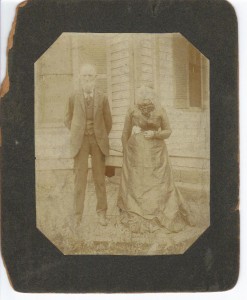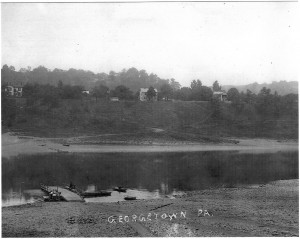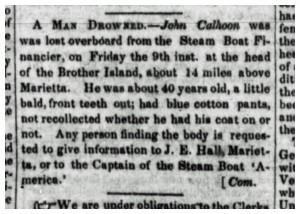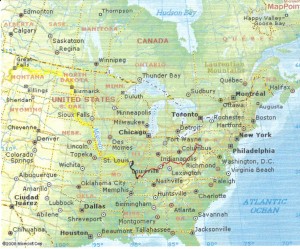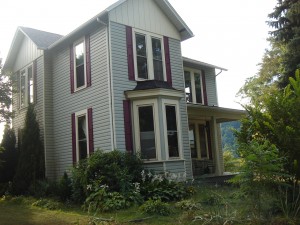Capt Thomas S Calhoon
Thomas Stevenson Calhoon was a riverman, first and last. He was born on 15 Aug 1834 in Georgetown, Beaver County, PA during the presidency of Andrew “Old Hickory” Jackson. The far famed captain died at his home in Georgetown on 3 Apr, 1910 at 11:30 in the morning after a short illness. He was married on Jan 8, 1867 to Harriet Amanda Calhoun, the daughter of Charles Calhoun and Harriet Rebecca Darrington from Burgettstown, Washington County, PA. Although the names were similar, the Georgetown Calhoons were prideful of the double “o” spelling of their name. With Harriet Amanda, he had two children Harriet Darrington and Mary Elise. His wife often remarked that most of her forty-three years of married life was spent saying goodby to her steamboating husband and then waiting till he returned. [1]
Captain Calhoon was a Democrat, a member of the Mason fraternity, and a member of the Methodist Episcopal Church of Georgetown. Like his neighbor Capt Jacob Poe , he was a large-hearted humanitarian. During the great flood of 1884, Capt Calhoon at considerable risk transported relief supplies down river to flood victims in the Ohio River valley. These steamboat owners and operators were a close group who would help each other during financial adversity. IOUs unredeemed of more than $100,000 were found after Thomas S Calhoon’s death. It was said the money was lent or given freely and gladly to help his friends.
According to Capt Frederick Way Jr, “measured by standards of capability, pure skill as a captain, he had no peer above Cincinnati in his day”.[2] Many Ohio River pilots honored Capt Calhoon after he retired. As they would steam past his home, they would salute with a long, loud blow of their whistles at Mile 38.9 from Pittsburgh. The tributes continued long after the legendary Capt Calhoon’s death. The tribute became common practice of all pilots although the tribute was transformed to a loud blow for good luck at Georgetown. Like everything else, the original meaning of the tribute faded from memory with the lapse of time.
In the photo of Georgetown circa 1880, the three homes along the bluff overlooking the river were built by Thomas S Calhoon, Thomas W Poe, and Jackman T Stockdale. Although the profile of the river has changed, the three homes continue their watch over the beautiful Ohio.
Family Background.
Thomas S Calhoon’s grandfather, William Calhoon, was a farmer in Greene Township, Beaver County, PA. William’s wife Elizabeth Hutchinson survived him many years and was the mother of ten. All eight of her sons became river captains. Born on the farm near Georgetown, John was the eldest son. He was the captain who drowned in the Ohio River at Marietta in 1846 while in command of the Poe packet Financier. A newspaper article from the Marietta Intelligencier on 14 May 1846 reported the incident. Joseph MC, the youngest son, was a cholera victim whose body was returned to Georgetown with great difficulty from St Louis in 1850. Life as a steamboat man was dangerous work. That account is found on the page – The Body. Daughter Elizabeth died young. Mary became the wife of Capt Jackman T Stockdale.
John, Thomas S Calhoon’s father, married Nancy Stevenson. She died in 1847 shortly after her husband drowned leaving their seven young children in the care of Richard Calhoon. Thomas S lived with his uncle Richard until his marriage in 1867.
River Career.
Thomas S Calhoon began his life on the river at an early age. When he was fourteen, he made a trip to Nashville on the steamer Caledonia. The Caledonia was owned by his uncle Capt Richard Calhoon. In 1856-58 Thomas S Calhoon began his distinguished river career as the clerk of the steamer Metropolis. In 1859, he moved to become second clerk of the steamer Belmont. Whether he worked for Jacob Poe, an original partner in the ownership of the Belmont, or Samuel C Trimble who acquired the Belmont in the spring of 1859 is unclear. In 1860, he was clerk aboard the Kenton. In 1862, he got his first captain’s license. He moved to the John T McCombs whose owner placed him in command of the vessel. The John T McCombs, built in 1860, achieved fame as the first Ohio River packet to carry a calliope. He worked the Pittsburgh to Wheeling trade.
With John N McCurdy, Thomas S Calhoon bought the Citizen and sold the Citizen in the same year for $15,000. John N McCurdy was the brother of Elizabeth McCurdy who was the wife of Richard Calhoon. During that time the Citizen was commanded by Richard Calhoon. It is unclear whether there was any profit in this venture.
Later in 1862 Thomas S Calhoon with John N McCurdy, Richard Calhoon, and William White as equal partners acquired the steamer Leonora for $20,000. With Richard Calhoon its master and Thomas S Calhoon clerk, the Leonora was contracted by the Army Quartermaster during the Civil War to transport troops to Cairo, Nashville and Louisville. The Leonora was part of the expedition to Pittsburg landing in Apr 1862 to remove sick and wounded soldiers. The Leonora was sold for $9,767.12 to work on the Missouri.
The same four men, Thomas S Calhoon, John N McCurdy, Richard Calhoon, and William White, bought the streamer Horizon for $20,000 from Jackman Taylor Stockdale. The Horizon was charted by the Army Quartermaster.
During the siege of Vicksburg, Capt Thomas S Calhoon assumed command of the Horizon. The boat was also chartered from 5 Jan 1863 to 1 May 1863. During that contract period, the Horizon was used to run past the guns at Vicksburg with six other transports. For this dangerous mission, the civilian crew, except for its pilots, was replaced by Army officers and men.[3] Capt Calhoon ran the batteries. He was in charge of the Horizon when she collided with the Moderator later that May. The collision, a Civil War tragedy where many soldier lives were lost, occurred near Vicksburg. Both boats were running the Confederate batteries at night without lights. A genealogy report indicates that indemnity was requested, but refused by the government. Dana Gibson lists a government payment of $18,500 for the loss of the vessel. [4] No evidence to confirm payment has been discovered.
After the Civil War, Capt Calhoon worked on the upper Missouri River although in 1865, he commanded the Amelia Poe owned by Thomas W Poe on a trip up the Red River in LA. In 1866 he was the first clerk on the Amelia Poe on a trip from Cincinnati to Ft Benton. The other officers were Capt Thomas W Poe, Clerk JQA Parr, Engineer Jacob Ewing, and first steward George Calhoon. All Georgetown men.
On 5 Mar 1867 twenty-eight days after his wedding on 5 Feb 1867, Thomas S Calhoon, as clerk on the Ida Stockdale, departed for far off Ft Benton. It was an exciting season. Army personnel were among the passengers. First the boat was blocked for hours by an impassible herd of buffaloes crossing the Missouri. The steamer was ambushed by Indians. He wrote home in 1867 that they “were treated to a volley of arrows. One struck the chimney and fell to the deck, and one struck the spar and stuck into it.”[5] The newly married couple did not see one another until late that fall. [6]
Capt Jackman Taylor Stockdale owned the Ida Stockdale a famous steamer in her day. During the gold rush years, the Ida Stockdale achieved fame as one of three sternwheel packets to complete the dangerous journey to Ft Benton five times. [7] In 1867, the Ida Stockdale profits were $42,594 — the greatest of any of the forty boats on the river that season.[8] That amount in 2007 dollars is between $596,379 and $950,979 depending on the inflation calculator used. Either number is prodigious. By any standard, these Georgetown men were wealthy.
In 1867-8 partners Thomas S Calhoon and Jackman T Stockdale built the Sallie for the mountain trade. The Sallie was a wooden hull sternwheel packet built in McKeesport and finished in Pittsburgh. Rated at 399 tons, the Sallie ran to Ft Benton three years with Capt Calhoon in command. The ownnership was 2/3 Thomas S Calhoon and 1/3 Jackman T Stockdale. The cost of the Sallie was $29,457.83.
The Sallie made the fastest trip ever to Ft Benton. The following dates are provided by a genealogy report and taken from Thomas S Calhoon’s diary. On 15 Mar 1868, the Sallie left Pittsburgh for St Louis; departed St Louis on 9 Apr 1868; arrived at Ft Benton on 26 May 1868; returned to dock at St Louis on 10 Jun 1868. That was 47 days out of St Louis and the fastest time to that date.
On the 1868 trip, the Sallie gross receipts were $33,508.92 with a profit of $12,747.69. In addition to his share as an owner, Thomas S Calhoon earned a salary of $6,138.35. By the way, Horace Bixby, one of the pilots that year, was the man who taught Mark Twain river piloting.
After commanding the Sallie to Ft Benton in 1869, Capt Thomas S Calhoon with pilots Jacob Poe and Andrew H Parr delivered the packet Barranquilla to New Orleans. Its ultimate destination was the Magdalena River in Columbia, South America. On 23 Aug 1869, the Georgetown officers departed the Pittsburgh boatyard and arrived in New Orleans on 11 Sep 1869. The route from New Orleans to the Magdalena River was long and dangerous. From New Orleans the packet with a Gulf of Mexico pilot sailed along the coast to Key West. From there she island hopped via Jamaica to reach her destination; badly battered but operative. Sternwheel packets were not designed for ocean adventures. The distance these men traveled was incredible.
Again as partners Thomas S Calhoon (2/3 owner) and Jackman T Stockdale (1/3 owner) built the Glencoe in Shousetown for the St Louis to New Orleans trade when the Anchor Line was just starting business. Launched on 1 Nov 1870, the Glencoe was commanded by Capt Thomas S Calhoon with JQA Parr clerk. The Glencoe plied the lower Mississippi until she snagged and sunk near Vicksburg on 28 Oct 1877.
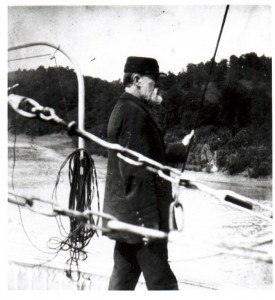
Capt Thomas S Calhoon making a landing (Photo courtesy of Murphy Library, University of Wisconsin – La Crosse)
Capt Calhoon returned to Pittsburgh to take command of the Katie Stockdale owned by Thomas S Calhoon, Jackman T Stockdale and his brother Willis Stockdale. The Katie Stockdale ran the Pittsburgh to Cincinnati trade for 18 years till it sank on 2 Aug 1895 at the Pittsburgh wharf. Capt Calhoon was master for 13 of those years. The high water mark of his career was when he became half owner of the Katie Stockdale and Vice President of the Pittsburgh and Cincinnati Packet Line. In 1878, round trip fare between Pittsburgh and Cincinnati was $10. In 1889, round trip fare was $12. Round trip fare to the World’s Fair in Chicago in 1893 was $18.
In 1890, Capt Calhoon and others built the Keystone State for the Pittsburgh to Cincinnati Line. Capt Calhoon was her master for 5 years. When Capt John N Philips resigned command of the Iron Queen, Capt Calhoon succeeded him. He was aboard the Iron Queen for only three trips before she was destroyed by fire.
The last boat he commanded was the Virginia. The Virginia was the ultimate in luxurious travel. Before the Broadway Limited of railway fame, the Virginia cruise from Pittsburgh to Cincinnati was a trip of breathtaking elegance and adventure. The cabin was 190 feet long with 50 state rooms. Each state room had an upper and lower berth. The mattresses, sheets, and pillows and linens were proved by Joseph Horne and Co, the famed department store in Pittsburgh. An upright piano in the ladies cabin was provided by Kappel Music House. The full length hallway was also used as the dining area. Tables could be finely set for 120 passengers and officers.

Capt Thomas S Calhoon (left) aboard the Virginia 1896 (From the Collection of The Public Library of Cincinnati and Hamilton County)

The Virginia passing under the Wabash Bridge note the stacks (From the Public Library of Cincinnati and Hamilton County.
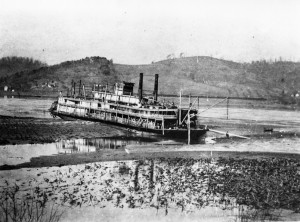
Str Virginia in cornfield in 1910 (courtesy of the Public Library of Cincinnati and Hamilton County)
Capt Calhoon was not the master when the Virginia unceremoniously settled in a cornfield in Willow Grove, WV due to high water. A Pittsburgh engineering firm managed to move her back into the water. When the Pittsburgh Cincinnati Packet Line folded due to the favored railroad travel, the Virginia went through a series of changes until she was dismantled in New Orleans.
Summary.
In reading about the life of Thomas Stevenson Calhoon, I was constantly surprised at his achievements. He was on of the few river men who stayed until the river commerce disapeared and nothing was left but the scenery.
Along with his fellow steamboat captains from Georgetown, they weres alone in their class: risk takers, doers, princes of the rivers during the Golden Age of Steamboats. Too important to forget, their story is a classic with which every American should be familiar.
Both Harriet Amanda and Thomas S Calhoon are buried in the Georgetown Cemetery overlooking the town and Ohio River. The Calhoon markers are aligned with the Main Street with a direct view of their home and the Ohio River.

Thomas S Calhoon Family Stone 2008 (F Nash Collection)
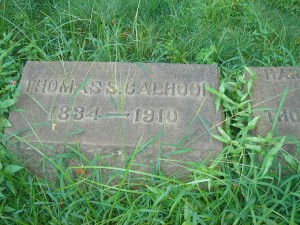
Thomas S Calhoon Marker 2008 (F Nash Collection)
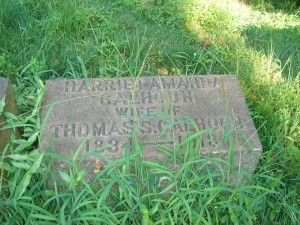
Hariet Amanda Calhoon Marker 2008 (F Nash Collection)
References.
[1] Jim Mullooly, Married Women from Burgettstown, Observer Reporter, Washington, PA, Jun 6, 1973.
[2] Capt Frederick Way, Jr., The Steamboating Poe Family, (S&D Reflector) ( 1964)).
[3] Frederick Way, Jr.,Way’s Packet Directory, 1848-1994, (Ohio University Press, Athens 1994), p. 217.
[4] Charles Dana Gibson and E Kay Gibson, Dictionary of Transports and Combatant Vessels Steam and Sail Employed by the Union Army 1861 – 1868, (Ensign Press, Cambridge, MA 1995), p 152.
[5] Capt Frederick Way, Jr., History in Houses, (S&D Reflector (Dec 1969)).
[6] James F Mullooly, Steamboat ‘Round the Bend, Weirton Daily Times, Jun, 18, 1973.
[7] John G Lepley, Packets to Paradise Steamboating to Fort Benton, (River & Plains Society, 2001), p 25.
[8] Joel Overholser, Fort Benton World’s Innermost Port, (River & Plains Society, 1987), p. 62.
Copyright2010 © Francis W Nash
All Rights Reserved
No part of this website may be reproduced without permission in writing from the author.
